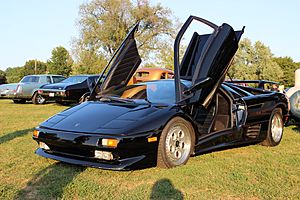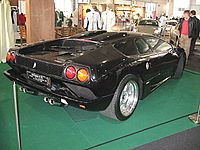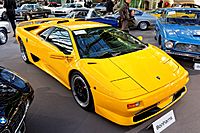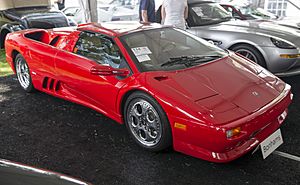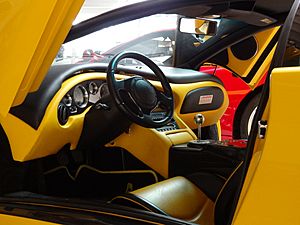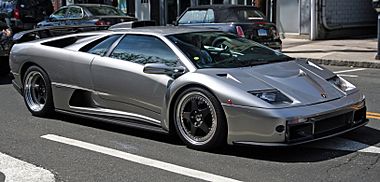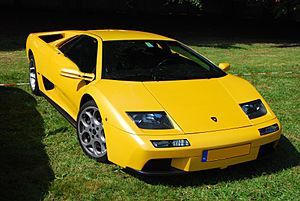Lamborghini Diablo facts for kids
Quick facts for kids Lamborghini Diablo |
|
|---|---|
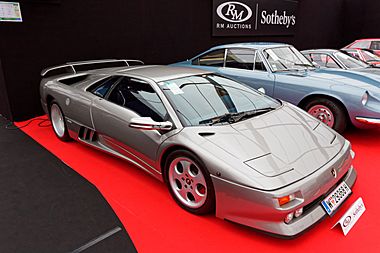
Lamborghini Diablo SE30
|
|
| Overview | |
| Manufacturer | Lamborghini |
| Production | 1990–2001 2,884 produced |
| Assembly | Italy: Sant'Agata Bolognese |
| Designer |
|
| Body and chassis | |
| Class | Sports car (S) |
| Body style | 2-door coupé 2-door retractable hard-top convertible (roadster) |
| Layout | Longitudinal, Mid-engine, rear-wheel drive / all-wheel drive |
| Doors | Scissor |
| Related |
|
| Powertrain | |
| Engine | 5.7 L V12 6.0 L V12 |
| Transmission | 5-speed manual |
| Dimensions | |
| Wheelbase | 2,650 mm (104.3 in) |
| Length | 4,460 mm (175.6 in)–4,470 mm (176.0 in) |
| Width | 2,040 mm (80.3 in) |
| Height | 1,105 mm (43.5 in)–1,115 mm (43.9 in) |
| Weight |
|
| Chronology | |
| Predecessor | Lamborghini Countach |
| Successor | Lamborghini Murciélago |
The Lamborghini Diablo is a super cool sports car built by Lamborghini. It was made from 1990 to 2001. The name Diablo means "devil" in Spanish. This amazing car took the place of the famous Countach. Lamborghini built all 2,884 Diablos in Sant'Agata Bolognese, Italy. After the Diablo, Lamborghini created the Murciélago.
Contents
History of the Diablo
The Diablo was designed by Marcello Gandini. Lamborghini wanted this new car to go super fast, aiming for a top speed of 196 miles per hour (315 km/h). The very first Diablo was shown to the public in January 1990. It was produced until 2001 before the Murciélago took its place.
Different Diablo Models
Lamborghini made several different versions of the Diablo. After its first release in 1990, it got a new look in 1998. Production continued until 2001.
First Generation (1990-1998)
The Original Diablo
Lamborghini first showed the Diablo on January 21, 1990. It had a powerful 5.7 L (348 cu in) Lamborghini V12 engine. This engine produced 492 PS (362 kW; 485 hp) and 580 N⋅m (428 lbf⋅ft) of torque. The Diablo could go from 0 to 100 km/h (62 mph) in about 4.5 seconds. Its top speed was an incredible 325 km/h (202 mph). The car was rear-wheel drive, meaning power went to the back wheels. Its engine was placed in the middle of the car.
Diablo VT: All-Wheel Drive Power
Lamborghini introduced the Diablo VT in 1993. The VT was special because it was the first Lamborghini to have all-wheel drive. This system sends power to all four wheels, giving better grip. The VT also had other new features like power steering, which made it easier to drive. Many of these new features later became standard on the regular Diablo.
Diablo SE30 and SE30 Jota: Special Editions
The Diablo SE30 was revealed in 1993. It was made to celebrate Lamborghini’s 30th anniversary. The SE30 was lighter and more powerful than the standard Diablo. Its engine was boosted to 530 PS (390 kW; 523 hp). Like the original, the Diablo SE30 was rear-wheel drive.
Lamborghini built 150 Diablo SE30s. Out of these, fifteen were turned into the "Jota" version. The "Jota" upgrade made the Diablo SE30 even more focused on track racing. The Jota’s engine was super powerful, making 603 PS (444 kW; 595 hp) and 639 N⋅m (471 lb⋅ft) of torque.
Diablo SV: Super Veloce
Lamborghini showed the Diablo SV at the 1995 Geneva Motor Show. The "SV" stands for "Super Veloce," which means "super fast." The SV was based on the standard Diablo, so it did not have the VT’s all-wheel drive system. Even though it was more powerful, the Diablo SV actually cost less than the standard Diablo. It made 517 PS (380 kW; 510 hp) at 7,100 rpm and 580 N⋅m (428 lbf⋅ft) of torque at 5,900 rpm.
Diablo VT Roadster: Top Down Driving
Lamborghini introduced the Diablo VT Roadster in December 1995. This was the convertible version of the VT. It used the same all-wheel drive system as the VT coupe.
In 1998, Lamborghini made the Diablo VT Roadster even more powerful. Its engine now produced 530 hp (395 kW; 537 PS). This power boost increased the car’s top speed to 335 km/h (208 mph).
Second Generation (1998-2001)
Diablo SV (1999): The New Standard
The Diablo got an update in 1999. Lamborghini stopped making the standard Diablo model that year. This was because the Diablo SV had become the new basic Diablo model.
Lamborghini also changed the inside of the Diablo, giving it a fresh look.
The power of the Diablo SV was increased to 536 PS (394 kW; 529 hp) and 605 N⋅m (446 lb⋅ft) of torque.
Diablo VT and VT Roadster (1999): Updated All-Wheel Drive
The second-generation VT models were very similar to the first ones. However, they had a few updates. These included an engine that was tuned to make 536 PS (394 kW; 529 hp). The VT models kept their important all-wheel drive system.
Diablo GT: Built for the Track
Lamborghini revealed the Diablo GT in 1998. This car was mainly designed to be used for track racing. The Diablo GT was lighter than the standard Diablo. The size of the Diablo GT’s engine was increased to 6.0 L (366 cu in). This powerful engine made 583 PS (429 kW; 575 hp) and 630 N⋅m (465 lb⋅ft) of torque. A version of the Diablo GT’s engine was later used in the Diablo VT 6.0.
Diablo VT 6.0 and VT 6.0 SE: The Final Diablos
Lamborghini introduced the Diablo VT 6.0 in 1994. It shared its powerful engine with the Diablo GT. This engine made 557 PS (410 kW; 549 hp) and 620 N⋅m (457 lb⋅ft) of torque.
There were only two versions of the Diablo VT 6.0: an all-wheel drive version and a two-wheel drive version. This was because Lamborghini was already busy working on its next super car, the Murciélago.
Images for kids
See also
 In Spanish: Lamborghini Diablo para niños
In Spanish: Lamborghini Diablo para niños


